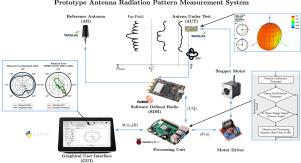基于软件定义无线电的天线辐射方向图测量系统原型的研制
IF 2.1
Q3 ENGINEERING, ELECTRICAL & ELECTRONIC
引用次数: 0
摘要
这项工作介绍了一个用于测量天线辐射方向图的自动化原型系统的设计和实现,该系统使用软件定义无线电(SDR)、步进电机驱动的旋转平台和定制的3D打印组件。该系统由树莓派处理器驱动,配有触摸屏界面,用于实时控制和数据可视化。该原型机可在水平(方位角)或垂直(仰角)平面上实现360°自动扫描,便于在低于6 GHz的宽频率范围(70 MHz - 5.9 GHz)内进行信号强度测量。通过测量远场条件和非消声环境下超宽带(700 ~ 6000 MHz)柔性天线的辐射方向图,验证了该样机的实际适用性和可接受的精度。通过将测量的辐射模式与制造商的参考数据进行比较来评估性能,得出的均方根误差(RMSE)和平均绝对误差(MAE)分别低于0.172 (3.260 dB)和0.139 (2.625 dB)。这些结果表明,该原型为天线表征提供了一种低成本、可靠、模块化和适应性强的解决方案,适用于学术研究和实际电信应用。此外,硬件和软件都是开放源码的,这提高了复制的便利性,并支持未来的增强。本文章由计算机程序翻译,如有差异,请以英文原文为准。

Development of a prototype antenna radiation pattern measurement system using Software-Defined Radio
This work presents the design and implementation of an automated prototype system for measuring antenna radiation patterns, using Software Defined Radio (SDR), a stepper motor-driven rotational platform, and custom 3D printed components. The system is powered by a Raspberry Pi processing unit, equipped with a touchscreen interface for real-time control and data visualization. The prototype enables automated 360°sweeps in either the horizontal (azimuth) or vertical (elevation) plane, facilitating signal strength measurements across a broad sub-6 GHz frequency range (70 MHz – 5.9 GHz). The prototype was validated by measuring the radiation pattern of an ultra-wide band (700 to 6000 MHz) flexible antenna under far-field conditions and in non-anechoic environment, demonstrating its practical applicability with acceptable accuracy. Performance was evaluated by comparing the measured radiation patterns against the manufacturer’s reference data, yielding a root mean square error (RMSE) and a mean absolute error (MAE) below 0.172 (3.260 dB) and 0.139 (2.625 dB), respectively. These results indicate that the prototype offers a low-cost, reliable, modular, and adaptable solution for antenna characterization, suitable for both academic research and practical telecommunications applications. Furthermore, the hardware and software are open source, promoting ease of replication and enabling future enhancements.
求助全文
通过发布文献求助,成功后即可免费获取论文全文。
去求助
来源期刊

HardwareX
Engineering-Industrial and Manufacturing Engineering
CiteScore
4.10
自引率
18.20%
发文量
124
审稿时长
24 weeks
期刊介绍:
HardwareX is an open access journal established to promote free and open source designing, building and customizing of scientific infrastructure (hardware). HardwareX aims to recognize researchers for the time and effort in developing scientific infrastructure while providing end-users with sufficient information to replicate and validate the advances presented. HardwareX is open to input from all scientific, technological and medical disciplines. Scientific infrastructure will be interpreted in the broadest sense. Including hardware modifications to existing infrastructure, sensors and tools that perform measurements and other functions outside of the traditional lab setting (such as wearables, air/water quality sensors, and low cost alternatives to existing tools), and the creation of wholly new tools for either standard or novel laboratory tasks. Authors are encouraged to submit hardware developments that address all aspects of science, not only the final measurement, for example, enhancements in sample preparation and handling, user safety, and quality control. The use of distributed digital manufacturing strategies (e.g. 3-D printing) is encouraged. All designs must be submitted under an open hardware license.
 求助内容:
求助内容: 应助结果提醒方式:
应助结果提醒方式:


